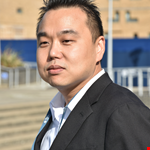Development of a new flexible manipulator integrating contact force sensors and shape sensors for MIS (minimally invasive surgery).
There are a number of problems associated with the existing needle drivers and grippers for minimally invasive surgery. They are integrated into a rigid cylindrical hollow rod, so the workspace and maneuverability of those devices are limited when accessing small openings and narrow spaces in the body, and using them can result in damaging soft tissues and organs, so the patients may suffer from aftereffects following the surgery.
To overcome the barriers of such conventional medical devices, flexible manipulators have been developed. Although the workspace and maneuverability of the flexible manipulator outperform those of the conventional ones, there are further challenges to overcome: measuring its shape sensing, and its body force measurement. To facilitate shape sensing, different methods have been proposed by vision (camera) and Fiber Bragg Grating (FBG) for flexible manipulators.
The sensing performance is very accurate, but the device called “interrogator” which can detect strain values from the FBGs attached to the mechanical sensor flexure costs around £20000, and manufacturing the bending sensor is too complicated so that it spends a long time fabricating it. Moreover, it is required for electrical noise filtering and temperature compensation, and the maximum measurable sensing frequency ranges are limited up to 50 Hz.
In some devices, the body force sensors have been integrated into each of the manipulator’s joints. Depending on the manipulator’s shapes, the sensors measure external forces and internal forces (caused by wires or air pressure), with the external force decoupled by a mechanical mathematic model. However, decoupling the external force is quite complicated because the mathematical model is not always predictable.
The geometry of conventional force/torque sensors is not suitable to be integrated into the flexible manipulator since they have no ample space allowing wires or pipes to be passed through it.
For these reasons, in this project, we have set out to develop a new flexible manipulator integrating contact force sensors and shape sensors using optoelectronic sensors. The main advantage of these contact force and shape sensors is that they can measure bending angles (shapes) and external force values very accurately, and at very little cost, and are simple to manufacture. Furthermore, they are very stable with a maximum measurable sensing frequency of more than 10 kHz, and low electrical noise.
This technology has also been adopted to work with shape sensing applications for haptic gloves and rehabilitation devices.

Dr Yohan Noh - He received his first B.Sc. degreefrom the Department of Mechanical Engineering, Seoul National University of Scienceand Technology, Korea (2002) and his second B.Sc. degree from the Department ofElectrical Engineering from Yonsei University, Korea (2004). He did his M.Sc. and Ph.D. atthe Department of Science and Engineering (robotics), Waseda University, Tokyo, Japan in2007 and 2011, respectively. After this, he worked as a research associate in Roboticswithin the Department of Biomedical Engineering and Informatics, King's College London.During his PhD and Postdoctoral studies in the UK and Japan, he studied and proposed agreat number of the robotic systems for use in medicine and healthcare in Japan, Korea,and the UK. His work has resulted in more than seventy peer-reviewed papers includingsixteen journal papers and more than seventy papers in top journals and conferences ofrobotics. He has eleven published patents so far.He has been fortunate to have the opportunity of involvement in commercialisationprocess of a number of joint projects between academia and industry. Being ambitious tolay out a research direction which considers commercialisation of the developed system inthe beginning of a project, led to successful commercialisation of the projects and therespective products are now being sold in international market.He has facilitated many collaborative activities between robotics groups in the UK, EU, andJapan through domestic and international joint projects (EU-project STIFF-FLOP, Grant No.287728), (Wellcome Trust IEH project iFIND, Grant No.102431), and (Robotics AdvancedMedical Cluster, Japan), and have been an active member of the robotics community (IEEERAS, EMBS, ASME, RSJ, JSCAS), and helped in the organisation of RSJ, ROMANSY, ICCAS,ROBIO, ICRA, and EMBC conferences since 2008.